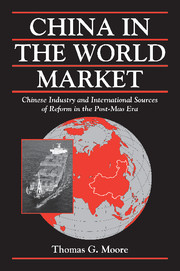Book contents
- Frontmatter
- Contents
- List of Figures
- List of Abbreviations
- Preface
- 1 China as a Latecomer in World Industrial Markets
- 2 The Outside World as an Impetus for Change in China
- 3 Tailor to the World: China's Emergence as a Global Power in Textiles
- 4 Beating the System with Industrial Restructuring: China's Response to the Multifiber Arrangement (MFA)
- 5 China Looms Large: Reform and Rationalization in the Textile Industry
- 6 Industrial Change in the Shadow of the MFA: The Role of Top-Level Strategy, Mid-Level Intervention, and Low-Level Demand in China's Textile Industry
- 7 Chinese Shipbuilding: The Modest Origins of an Emerging Industrial Giant
- 8 Dangerous Currents: Navigating Boom and Bust Cycles in International Shipbuilding
- 9 Chinese Shipbuilding and Global Surplus Capacity: Making a Virtue out of Necessity
- 10 Market-Oriented Solutions for Industrial Adjustment: The Changing Pattern of State Intervention in Chinese Shipbuilding
- 11 Who Did What to Whom?: Making Sense of the Reform Process in China's Shipbuilding Industry
- 12 External Shocks, State Capacity, and National Responses for Economic Adjustment: Explaining Industrial Change in China
- 13 China in the Contemporary International Political Economy
- Appendix Contours of the Research Effort
- Bibliography
- Index
13 - China in the Contemporary International Political Economy
Published online by Cambridge University Press: 07 August 2009
- Frontmatter
- Contents
- List of Figures
- List of Abbreviations
- Preface
- 1 China as a Latecomer in World Industrial Markets
- 2 The Outside World as an Impetus for Change in China
- 3 Tailor to the World: China's Emergence as a Global Power in Textiles
- 4 Beating the System with Industrial Restructuring: China's Response to the Multifiber Arrangement (MFA)
- 5 China Looms Large: Reform and Rationalization in the Textile Industry
- 6 Industrial Change in the Shadow of the MFA: The Role of Top-Level Strategy, Mid-Level Intervention, and Low-Level Demand in China's Textile Industry
- 7 Chinese Shipbuilding: The Modest Origins of an Emerging Industrial Giant
- 8 Dangerous Currents: Navigating Boom and Bust Cycles in International Shipbuilding
- 9 Chinese Shipbuilding and Global Surplus Capacity: Making a Virtue out of Necessity
- 10 Market-Oriented Solutions for Industrial Adjustment: The Changing Pattern of State Intervention in Chinese Shipbuilding
- 11 Who Did What to Whom?: Making Sense of the Reform Process in China's Shipbuilding Industry
- 12 External Shocks, State Capacity, and National Responses for Economic Adjustment: Explaining Industrial Change in China
- 13 China in the Contemporary International Political Economy
- Appendix Contours of the Research Effort
- Bibliography
- Index
Summary
THE “PROBLEM FOR ANALYSIS” REVISITED
The major conclusion of this book is that the international environment most propitious for the reform, restructuring, and rationalization of Chinese industries during the 1980s and early 1990s was one marked by moderate economic closure rather than the ideal-typic economic openness assumed by most observers. While this finding must be asserted tentatively given the limited number of cases examined here, evidence from the textile and shipbuilding industries indicates a need for further investigation into the impact of “free trade” and “managed trade” environments on change at the industrial level. Specifically, this book argues that the MFA in textiles and GSC in shipbuilding accelerated, rather than retarded, industrial transformation and export success. By contrast, the same type and degree of change was less pronounced when the world market was characterized by greater economic openness. For example, the silk sector of China's textile industry – one not subject to quotas until 1994 – lagged noticeably behind other sectors by every measure of industrial restructuring, including export upgrading, product diversification, and technological modernization. For their part, economic reform and industrial rationalization were also comparatively slow in the silk sector.
The remainder of this section provides a brief exploration of broader issues related to this central research finding. First, the discussion expands the empirical focus beyond textiles and shipbuilding to light industries such as toys, footwear, sporting goods, and household appliances. Second, it examines the durability and generalizability of its research findings.
- Type
- Chapter
- Information
- China in the World MarketChinese Industry and International Sources of Reform in the Post-Mao Era, pp. 295 - 315Publisher: Cambridge University PressPrint publication year: 2002



